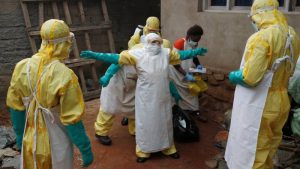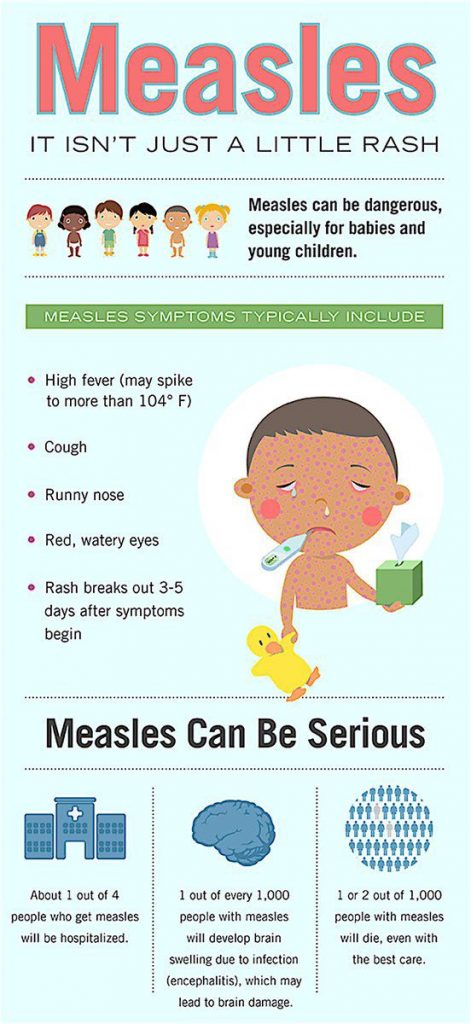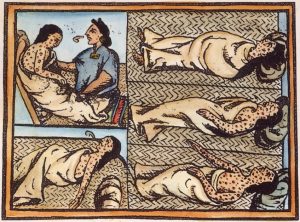
from the movie Carnosaur
We are currently enduring a coronavirus pandemic (COVID-19). But perhaps I can tell you some things about pandemics in general that you don’t know!
Writers note: you will find below several bits of information you absolutely must have if you are going to write a story involving a pandemic—or even an epidemic.

First you need to know the different levels of the disease’s severity within a community.
- Sporadic: a disease that occurs infrequently and irregularly (rabies, polio)
- Endemic: the constant presence and/or usual prevalence of a disease or infectious agent in a population within a geographic area (chicken pox in American schoolchildren, malaria in certain areas of Africa)
- Hyperendemic: persistent, high levels of an endemic disease occurrence, above the expected “normal” levels

- Epidemic: an increase, often sudden, in the number of cases of a disease above what is normally expected in that population in that area (Ebola in 2014, Zika in 2018)
- Outbreak: carries the same definition of epidemic, but is often used for a more limited geographic area
- Holoendemic: essentially every individual in a population is infected, though not all show symptoms (modern occurrences are not common, but one example is hepatitis B in some areas of the Marquesas Islands)
- Cluster: aggregation of cases grouped in place and time that are suspected to be greater than the number expected, even though the expected number may not be known
- Pandemic: is an epidemic so big it crosses international boundaries and affects large numbers of people.


Pandemics can occur in crops, livestock, fish, trees, or other living things, but I’ll be sticking with people here. You may want a plot line that has people battling a pandemic in another species. What happens to the food supply if all the wheat or corn or soybeans die off? How would people protect themselves from an entire population of aggressively rabid squirrels?
A wide-spread disease or condition that kills many people is a pandemic only if it is infectious. E.g., cancer and diabetes are not pandemics.
Until recently, I thought—in a vague sort of way—that pandemics were a thing of the past, mostly centuries ago. Wrong. Currently, besides COVID-19, HIV/AIDS is an active pandemic world-wide. For example, several African countries have infection rates as high as 25%, or even 29% among pregnant South African women.

Any given pandemic is seldom one-and-done. Maybe none of them are.


- Plague: contagious bacterial diseases that cause fever and delirium, usually along with the formation of buboes, sometimes infecting the lungs. In past centuries, plagues killed 20%, 40%, even 50% of a country’s population. The first U.S. plague outbreak was the San Francisco plague of 1900-1904.
- Writers note: isolated cases of plague still turn up in the western U.S.
- Influenza (a.k.a. Flu): the first flu pandemic recorded was in 1580, and since then influenza pandemics have occurred every 10 to 30 years
- Cholera: seems (to me) to be nearly perennial, with pandemics recorded 1871-1824, 1826-1837, 1846-1860, 1863-1875 (in 1866 it killed some 50,000 Americans), 1881-1896, 1899-1923, 1961-1975.
- Typhus (a.k.a., camp fever, gaol fever, and ship fever): caused by bacterial Rickettsia prowazekii and characterized by a purple rash, headaches, fever, and usually delirium. It spreads rapidly in cramped quarters, often carried by fleas, lice, and ticks. It’s common in times of war and famine.

- Smallpox: caused by the variola virus, it raged from the 18th century through the 1950s. Vaccination campaigns beginning in the 19th century led the World Health Organization to declare smallpox eradicated in 1979.
- Writers note: it is the only human infectious disease to have been completely eradicated. But for your purposes, maybe not!
- Measles: historically, before the vaccine was introduced in 1963, 90% of people had the measles by age 15. Measles is an endemic disease, so groups of people can develop resistance. But it is often deadly for those who get measles, and it has killed over 200 million people over the last 150 years. Worldwide, in 2000, measles killed 777,000 out of 40 million cases.
- Tuberculosis (a.k.a, TB): a very present danger, as new infections occur at a rate of one per second. A quarter of the world’s current population has been infected, and although most of those are latent, 5-10% will progress to active disease. Left untreated, TB kills more than half of its victims.
- Leprosy (Hansen’s disease): caused by a bacillus, it is a chronic disease. It has an incubation period up to five years, but it can now be cured. It’s been estimated that in the early 13th century, there were 19,000 leper hospitals (leprosariums) across Europe.
- Malaria: widespread in tropical and subtropical regions around the world.
- Writers note: consider the implications of climate change. Once common, malaria deaths became all but non-existent due to drug treatment. However, growing drug resistance is a major concern. Malaria is resistant to all classes of antimalarial drugs except artemisinins.

- Yellow fever: a viral infection carried by mosquitoes. In 1793, it killed approximately 10% of the population of Philadelphia.
- Ebola virus: one of several viral hemorrhagic fevers (along with Lassa fever, Rift Valley fever, Marburg virus, and Bolivian hemorrhagic fever) that seem to be pandemics in waiting because they are highly contagious and deadly. On the other hand, transmission requires close contact and moves fast from onset to symptoms, so effective quarantines are possible.
- And on the third hand, writers note: it could always mutate and adapt.
- Coronaviruses: a large family of viruses that cause illnesses ranging from the common cold to MERS-CoV, SARS-CoV, and the current Coronavirus-19, which is a new strain of SARS-CoV-2. Common effects of all of these are fever, cough, shortness of breath, and breathing difficulties.

Historians have identified five (sometimes six) “major pandemics” that have affected enough of the population to cause a significant change in the social order. They are often referred to as plagues, despite not being caused by the bacterium Yersinia pestis.

- The Plague of Justinian (541-543) continued to cause famine and death after the primary infection had been contained because the sudden lack of a labor force meant that crops weren’t planted and harvested.
- The horrific conditions during and after the plague are believed to have created an ideal atmosphere for the rapid spread of Christianity.
- Though he survived his infection, Emperor Justinian had to shelve plans to consolidate power and expand the Roman Empire.


- The Black Death of 1347 to 1351 is believed to have killed as much as half the world’s population.
- Historians have estimated that resulting labor shortage allowed for the end of the feudal system and the beginning of the Renaissance in Europe.
- The population of Greenland was so diminished that the Vikings didn’t have the manpower to continue their raids in North America.

- The Colombian Exchange is a general term used to cover all of the species of plants, animals, people, and diseases moved from one continent to another during the European invasion of North and South America.
- Smallpox, measles, mumps, influenza, and the bubonic plague are estimated to have killed as many as 90% of the native populations of some areas.
- There is evidence that the extreme loss of life may even have caused a shift in global climates, because so much farmland and pasture land was abandoned and returned to forest.
- Polio, hepatitis, encephalitis, and syphilis were transmitted to Europe from North and South America, sometimes introducing a more virulent strain than had previously been present.


- The Third Bubonic Plague began in 1855 and reached every part of the world before it died down in the 1960s.
- Researchers confirmed that the disease was spread by bacteria in flea bites, allowing for major breakthroughs in quarantine methods.
- Some of those early quarantines involved such draconian measures in colonized areas that they contributed to rebellions in Panthay, Taiping, and several regions of India.


- The 1918 Influenza outbreak, commonly known as the Spanish Flu, infected 500 million people around the world and killed more people than World War I. In 25 weeks, it killed more people than AIDS did in its first 25 years.
- The close quarters of soldiers involved in World War I contributed to the rapid spread, but the contagion raised public awareness of how disease is transmitted and how to prevent it.
- Note: The “Spanish” flu was present around the world, but it gained its name because the Spanish government did not censor information on the pandemic. Because most other countries worked to suppress information so as not to disrupt the war, people got the impression that the disease was coming from Spain, the source of their information.


- Though it was first reported in 1981, HIV/AIDS is believed to have originated in a mutated genetic strand of the virus from a monkey in the 1920s.
- Sex education in schools and sexual practices among some portions of the population (notably among sex workers) changed drastically to focus on safety.
- Because it was first prevalent among the gay community, many religious leaders claimed the virus was a divine sign that homosexuals were evil.

“Alien” diseases are more deadly than local ones. Writers note: what are the implications of colonizing Mars?

- In 1529, a measles outbreak in Cuba killed 2/3 of the natives who had previously survived smallpox.
- Malaria was a major threat to colonists and Native Americans when introduced to the Americas along with the slave trade.
- In Colonial times, West Africa was called “the white man’s grave” because of malaria and yellow fever.
- European explorers often had devastating effects on indigenous people—and vice versa. For example, some believe that the death of up to 95% of the Native American population of the new world was caused by old world diseases such as smallpox, measles, and influenza.
- On the other hand, syphilis was carried from the new world to Europe after Columbus’ voyages.

Many notable epidemics and pandemics involve transmission from animals to humans, zoonoses.
- Influenza/wild aquatic birds
- SARS-CoV/civet cats
- MERS-CoV/deomedary camels
- COVID-19/bats’
- Avian influenza (bird flu)/birds in Vietnam (a pandemic in waiting)

Writing about pandemics—or any disease, actually, you need to decide on:
- Name, fictional or real
- Check out this Modern Guide to Naming Diseases in the New Yorker
- Disease type/ who’s most susceptible (childhood/ common/ rare)
- Cause (bacteria, virus, parasite, fungus, imbalance of bodily humors, witchcraft, divine intervention, etc.)
- Transmission (airborne, body fluids, food or water, touch, telepathy, miasma, etc.)
- Virulence (how likely a person is to catch the disease after coming into contact with it)
- Length of the incubation period: a person could be showing symptoms and become infectious almost instantly or it could take years
- Symptoms of this disease
- Whether it’s treatable and/or curable
- How people react when they encounter someone with this disease
- For a first-hand idea of what people thought during the Black Death, check out this Eyewitness to History!

BOTTOM LINE FOR WRITERS: pandemic are tried and true for creative fiction, whether historical or current, sci-fi or known world, mystery/action adventure or romance. Go for it!

Happy Saint Patricks Day!
